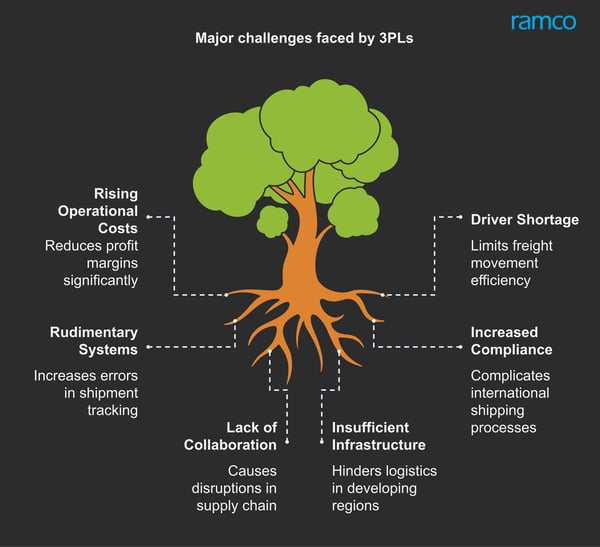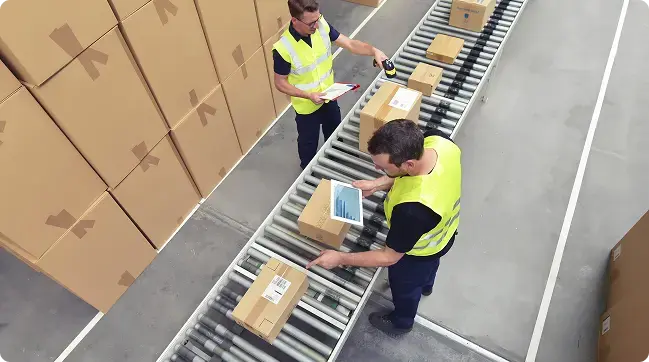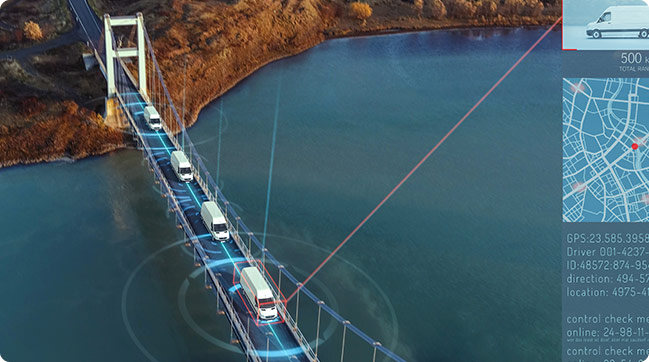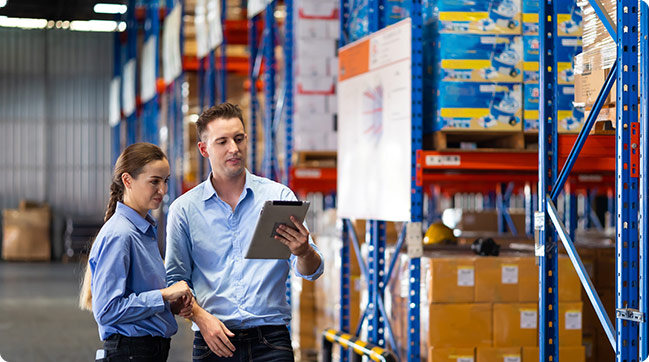In this Article
- Introduction
- Challenges for 3PLs
- Current Technology Landscape
- How can an integrated logistics platform help?
- Benefits of integrated logistics platform
- Conclusion
- About Ramco logistics platform
Introduction
For many years, Logistics Service Providers (LSPs) relied on large business suites, custom-built legacy applications, or point solutions to manage operations. However, with changing customer expectations, today’s LSPs need to elevate their service offerings and adopt integrated technology solutions. An Integrated Logistics Platform has become essential to meet these demands.
Modern 3PL service providers have evolved, enhancing their services and integrating technology to streamline the supply chain. Shippers now seek technology-driven 3PLs to improve efficiency, reduce costs, and scale operations.
This fusion of logistics and technology offers a complete, cohesive solution that not only addresses current market challenges but also positions businesses for sustainable growth.
In this eBook, you will discover how an integrated logistics solution can help you:
Improve Visibility across your entire supply chain
Maneuver supply chain disruptions effectively
Reduce costs through process optimization
Scale your business with agility and precision
By leveraging an integrated approach, LSPs can enhance the customer experience, future-proof their operations, and stay ahead of the competition. Download the full eBook to learn how you can transform your logistics operations and drive business growth.
Challenges for 3PLs

The most significant problems that 3PLs face are listed below:
Increasing cost of operations
It's tough to find a Logistics service provider who is not affected by the rise in the cost of operations. Rising fuel cost, manpower cost and the cost compliance adherence has created dent in the overall profit margins.
Driver shortage
More than 65% of entire freight in the US market is moved on the road. And the driver problem is here to stay, blame it on the age, demographics and skills. 3PLs are dancing on a dangerous cliff when it comes to handling driver shortage.
Rudimentary systems
A lot of small and moderate-sized 3PLs make use of Excel as well as Google Sheets to track and keep track of shipping. It can be a hassle with many shipments and multiple suppliers to keep the status and ETAs of every shipment up to date. There is also the possibility of errors and inaccuracies when reconciling inventory.
Increased compliance
Many 3PLs send shipments to various countries around the globe. The regulations and rules of every country could be different. Furthermore, regulations may differ even within a particular country. Rules and regulations change to make matters more complex. This is why growing compliance can be a huge problem for 3PLs.
Lack of collaboration or limited collaboration
End-to-end supply chains involve many participants, induding shippers, carriers, ports, customs and end consumers. Lack of collaboration could create disruptions and inefficiencies in the chain of supply.
Meet specific requirements of the shipper
An issue that 3PLs face is having to meet the shipper's demands on the packaging, on-time-in-full (OTIF) delivery, and customer service, among other things. This happen when there's a misinterpretation of the process on the part of the shipper on the 3PL's side. For instance, failing to include details of the 3PL number on packing slips can delay the arrival of goods.
Insufficient infrastructure
The issue is a common problem in developing countries where highways aren't maintained properly, internet connectivity is weak and insufficient, and insufficiently developed methods of transport, like roads and railways.
Constant shifts in demands
The constant shifts in demand for e-commerce create difficulties for 3PLs in planning. This creates challenges for the fulfillment and delivery of orders.
Capacity management in warehouses
The low or non-existent utilization of technology can cause this problem. It is more difficult because space isn't efficiently optimized.

Current Technology Landscape
Large business suites
Typically, 3PLs with a sizeable volume and business prefer a large business suite to handle their entire operations including booking, planning, hub management, warehouse management, line haul, last mile, invoicing, human resources and finance.
Though these large suite products provide multiple solutions that help Logistics companies operate, it always needs a middleware to operate as a single unified system.
These middleware needs multiple integration parameters, and it comes at a cost. The second downfall is that most of these big wig ERP systems were typically designed for manufacturer. Hence an LSP needs to force fit that system with multiple customizations to ensure the system helps the business process of a Logistics organization.
Point solutions
Smaller and Mid-sized 3PLs usually prefer point solutions that take care of a very specific need compared to a large suite solution that takes care of multiple operations. Most companies in this segment have limited capabilities in terms of business, for example some 3PLs may be strong in transportation and they would prefer just a Transportation Management solution alone. Though this methodology saves cost, the digital solution does not give a complete picture since every point solution acts independent of each other. It needs a complex integration to ensure seamless data flows.
Custom built solutions
While this is a traditional approach to building an IT blueprint for a 3PL, the growth of modern cloud-based software has eroded this kind of software. Having said that, there are good number of organizations even the larger ones, who still depend on legacy systems, since it gets the job done on a short-term basis. Age-old tech stack, lack of integration with third party software, outdated functionalities are some key reasons majority of 3PLs tend to move away from these solutions.
How can an integrated logistics platform help?

Two years ago, in 2020, more than two billion people bought items or services online, and online retailers' sales surpassed USD 4.2 trillion globally. The dynamics of business have transformed for both retailers and consumers. Consumers are more comfortable with online shopping, exploring options, looking beyond their locality, and even crossing boundaries. Retailers with established brands and start-ups have taken on digitalization; they are speeding to build an online presence.
In today's digital and global environment, companies seek an integrated logistics solution that will serve as the foundation of their business.
Integrated logistics systems improve business processes, from procurement and supply chain to customer returns and fulfillment. It anticipates customers' requirements and needs, purchases raw materials and coordinates delivery.
Integrated logistics is a service-oriented procedure aiming to create more effective and robust communication channels across the different business links. It helps companies maximize their resources and gain cost savings or competitive advantages.
The key to enabling the growth of e-commerce lies in the accessibility of a reliable logistics system. Companies can focus on their customers, products, and marketing with integrated, end-to-end logistics solutions.

Benefits of integrated logistics platform
Many businesses have adopted a unison approach to 3PL. Now the 3PL takes care bringing in the raw materials from a supplier to moving the finished goods from a manufacturing unit to retailers/distributors. Through an integrated logistics service approach, most of these functions can be managed and performed through a single service provider. To help shippers deliver goods on time and to overcome supply chain disruptions 3PLs need to look out for an integrated logistics solution that not only helps to improve efficiency but also helps 3PLs scale their business.

Some of the key benefits include:
Improved collaboration and visibility
Using an integrated logistics system, users can facilitate strong collaborations, which helps companies improve their operational control and reduce costs, streamlining processes and increasing the speed of response to customers. By integrating and aligning processes, every department can understand the entire process and see the elements they must meet their objectives.
Foretelling and meeting customers' demands
Among the benefits of digitalization is the usage of data. Through integrating the logistics system, processes like these are controlled by technology that gives access to information. 3PLs can now forecast demand, optimize routes, re-slot warehouses, foretell financial impact and more all with the data available in the system.
Depletion in the costs of operation
Every company aims to lower its operational expenses while simultaneously ensuring that customers are satisfied and the quality of its product. With an integrated logistics platform, the data flows seamlessly across multiple departments which automate operations, reduces cost, improves compliance and scales up operations.
Scale up
Growth of 3PLs is directly proportional to the number of customers they onboard. An integrated platform that supports multiple industries helps 3PLs scale up to customers across multiple industries with ease. The diversity in the kind of industries help 3PLs overcome any economic downturn if they place all their eggs in a single basket.
Reduction of waste
Logistics Organisations face a significant hurdle that increases their operations cost in the form of TIMWOOD. It refers to the types of waste that any 3PL faces in the form of Transportation, Inventory, Motion, Waiting, Over-Production, Over-Processing, and Defects. Among all TIMWOOD parameters, its Over Production that negatively impacts the profit of a 3PL player. With seamless data flow across multiple modules an integrated platform can deduce these wastes and present corrective actions.
Conclusion
A 3PL can significantly enhance supply chain efficiency by providing real-time data on the various elements that impact performance, identifying efficiency blocks, problems, and opportunities for improvement. Transparency across the supply chain empowers companies to make informed decisions that drive better outcomes at every level.
Given the current landscape, where many tech stacks still rely on large suites requiring middleware to connect fragmented point solutions, adopting an integrated logistics platform is the most effective path toward building a hyper-growth framework for 3PLs.
With Ramco's Integrated Solution, specifically designed for Logistics Service Providers, companies gain a competitive edge. This solution positions logistics organizations to not only embrace digitization but also scale and grow in the rapidly evolving logistics industry.
The future of logistics is integrated, and Ramco’s solution is your gateway to achieving operational excellence and sustainable growth.

About Ramco logistics platform
Ramco Logistics Platform provides a cloud-based integrated solution tailor-made for Third Party Logistics and Express Parcel Service Providers. The software helps to overcome key paint points, including supply shortages, limited resources, operational costs, the surge in demand and new compliance rules. The integrated solution encompasses Transportation Management System, Warehouse Management System, Fleet & Hub Management and Rating & Billing. Trusted by over 25+ logistics companies worldwide, the platform is powered by NextGen Al & ML features that help Logistics Service providers reduce cost and acquire new customers.
Download the eBook in PDF format and get your copy now
Save PDFYou may also like!
Elevating Growth for Third Party Logistics
End to End Digital Platform that reduces costs, improves efficiency, and increases customer retention











